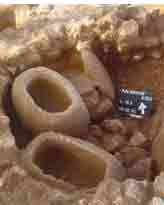
Burial Structures at Palmahim
A cemetery, dating to the Chalcolithic period (the fourth millennium BCE), was exposed in salvage excavations directed by Amir Gorzalczany, on behalf of the Antiquities Authority. The site, on which a desalinization facility is to be constructed, is located on a low kurkar ridge near the outlet of Nahal Soreq.
The cemetery consists of different-sized circular and rectangular burial structures, which, until now, were unknown on the coastal plain. The circular structures are 1.5–3.0 m in diameter, whereas the average rectangular structure is 1.5 x 3.0 m in size. The tombs, built of indigenous kurkar sandstone, were very well preserved, protected by a covering of sand dunes. Some of the tombs were covered by an in situ stone dome. Their entrances usually faced the north and were blocked with large stones, found in situ in some tombs. The structures contained many ossuaries (small coffins, c. 0.6 m long) made of the carefully polished indigenous kurkar, which were sometimes covered with a fitted stone slab-lid. The ossuaries were used for secondary burials, that is, they held the bones of the deceased that were gathered up sometime after the individual’s death. Several different kinds of stone ossuaries were uncovered; some of the ossuaries and the burial items were made of clay.
In most of the structures a standing stone (mazzeva) (often very large) was installed in the eastern wall, incorporated within the construction of the wall or set inside a special niche. All the mazzevot face east and are apparently related to some cult practice because in a number of instances, funerary offerings, such as pottery vessels, were found near them. The phenomenon of mazzevot (rectangular or oval) is well documented in other sites of the period.
More than fifty burial structures were found and the cemetery was probably very crowded. Nevertheless, some planning is evidenced by the presence, between the tombs, of a courtyard which was paved with small kurkar stones and was preserved over large parts of the site. The precise boundaries of the cemetery, as well as the settlement that was inhabited by the interred have not yet been traced .
Osteological remains were not found, probably due to the combination of climatic conditions and the site’s proximity to the sea. The artifacts include pottery vessels, flint tools characteristic of the period, beads and mazzevot of various types and sizes. The importance of this discovery is the revelation of a different, unknown so far, burial practice of the Chalcolithic period, The known Chalcolithic cemeteries in the center of the country consist of natural or rock-cut caves that contain ossuaries together with an abundance of funerary offerings. In the frontier regions (Negev, Sinai and Transjordan) the deceased were usually interred in circular stone structures.
The exposure of the cemetery at Palmahim, in the center of the coastal plain, its rare state of preservation and the combination of several methods of burial (in kurkar ossuaries and in burial jars) represent a significant contribution to our understanding of the burial patterns of the Chalcolithic period.
Upon the completion of the excavation, which was financed by the Via Maris Company, a plan was initiated to transfer some of the structures that represent each type of burial to a location where they can be displayed to the public.
Additional Articles ...